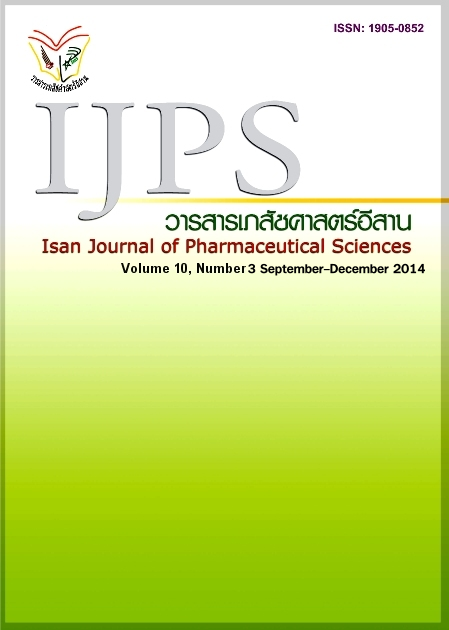Factors influencing calcium-containing food consumption among lower secondary students in Khon Kaen Province
Main Article Content
Abstract
Calcium is an essential mineral in the process of bone formation and maintenance. If human body doesn’t obtain sufficient calcium, the bone mass density will be low and as a consequence osteoporosis mal develop. Building bone mass density must be done from childhood by taking food containing high calcium regularly. According to the theory of planned behavior, intention is an immediate determinant of behavior. This suggests that intention to consume calcium is a significant factor in determining calcium intake behavior. Objectives: The objective of this cross-sectional survey was to identify associations between the following factors and the intention to consume calcium-containing food. These factors were three socio-demographic factors (gender, age and daily allowance), six psychological factors (attitudes towards negative effect of calcium to the body, attitudes towards health benefit of calcium to the body, attitudes towards necessity of taking calcium on a regular basis, attitudes towards preventing osteoporosis, perceived behavior control and support from family), three cognitive factors (knowledge about calcium, information about calcium and interest in receiving update calcium) and one social factors (social conformity). Method: Self administered questionnaire and food intake record forms were used to collect data. Food intake was prospectively collected for three consecutive days. The studied subjects were 1,037 lower secondary students in Khon Kaen province recruited with multi-stage sampling technique. Data were collected between June and August 2013. Results: Stepwise multiple linear regression analysis showed that of thirteen factors being studied, six factors were statistically significantly associated with the intention (P-value <0.05). These factors were male gender (Std.β=0.064), daily allowance (Std.β=0.148), attitudes towards negative effect of calcium to the body (Std.β=0.124), perceived behavior control (Std.β=0.295), social conformation (Std.β=0.092) and support from family (Std.β=0.393). These six factors explained 47.5% of the variation of the intention (R2 = 0.475). The association between the intention and calcium intake behavior was not statistically significantly. Conclusion : A program to promote calcium consumption should target not only lower secondary students, but should also consider their families and peers. The program should focus on promoting positive attitudes towards calcium consumption and identifying strategies to make calcium consumption become one of the significant social values of lower secondary students. Interventions to increase perceived behavior control of the consumption of calcium-containing food should be explored.
Article Details
In the case that some parts are used by others The author must Confirm that obtaining permission to use some of the original authors. And must attach evidence That the permission has been included
References
Bamrungyat T. The effects of application by self-regulation and social support for behavioral modification on weight reduc¬tion among secondary school students of Kalayanawat school Khon Kaen Province.Thesis in Health Education and Health Promotion. Khon Kaen: Khon Kaen University; 2006.
Chanaeam S. General Psychology .13thed. Bangkok: Thai Wattanapanich press; 2001.
Kaewkangwarn S. Psychological development throughout lifespan. 7thed. Bangkok: Thammasat press; 1997.
Khunawutikunakorn D. Awareness of the impor¬tance of calcium and consumption of calcium containing foods among second¬ary students, Suraskmontri school. Thesis in Public Health. Nakhon Pathom: Ma¬hidol University; 2000.
Larson NI, Story M, Wall M, Neumark-Sztainer D. Calcium and dairy intakes of adolescents are associated with their homeenviron¬ment, taste preferences, personal health beliefs, and meal patterns. J Am Diet Assoc. 2006; 106(11): 1816-24.
Niumsanit R, Sila S, Tawornpituk S. An analysis of Factor to Milk Drinking Habit of Stu¬dent Groups in the Northeastern Area by using technique of discriminant analysis: a case study. Khon Kean University; 1987.
Nannaly J. Psychometric theory. New York: Mc Graw-Hill; 1978.
Pratoomchat P. Nutrition promotion for adolescent students through the participation of teachers and students at Pugtupattana-suksa school. Thesis in Public Health. Khon Kaen: Khon Kaen University; 2006.
Poungpun W. Calcium Consumption of Early Adolescent Students in Rural Area : a Case Study in Tasalaprachanuson School, Manchakheree District, Khon Kaen Province. Thesis in Public Health. Khon Kaen: Khon Kaen University; 1999.
Rangsipaht T, Narmyai K, Sriassawaamorn N, Saengruang-Orn S. The Comparison of Bone Mineral Density Between 2nd Year Privates and New Privates by Using Calcaneal Quantitative Ultrasound . RTA Med J. 2010; 63: 65-70.
Sokal RR, Rohlf F.J. Biometry. New York: W.H. Freeman and Company; 1995.
Sriring P, Kanjanarach T, Krass I. Calcium Con¬sumption and Preferences for Vegetable Base Calcium Product of Women in Khon Kean Province, Thailand. Res Social Adm Pharm. 2012;8(6); e22.
Sriring P, Krass I, Kanjanarach T.Calcium Con¬sumption for Osteoporosis Prevention: Knowledge, Attitudes and Behavior in the Northeastern Region, Thailand. J Med Assoc Thai. 2014 ; 97(2): 232-40.
Swangbumrung M. Psychology and human behavior. Chiang Mai: Krong Chang Printing; 2009.
Susiyanti AE, Chamber E, Lewis NM. Calcium intake,attitudes toward calcium-containing foods and number of risk factors for osteoporosis in two groups of 18 to 35 years old woman. Nutr Res.1996; 16(8); 1313-1329.
Sutatworawut U. Peak Bone Mass and Relates Factors. Siriraj Medical Journal. 2005; 57(9); 404-406.
Wutiyasakul P. Calcium consumption of early adolescent students in a rural area: a case study in Tasalaprachanuson school, Manchakheree district, Khon Kaen Pro vince. Thesis of Master of Public Health. Khon Kaen: Khon Kaen University; 1999.


